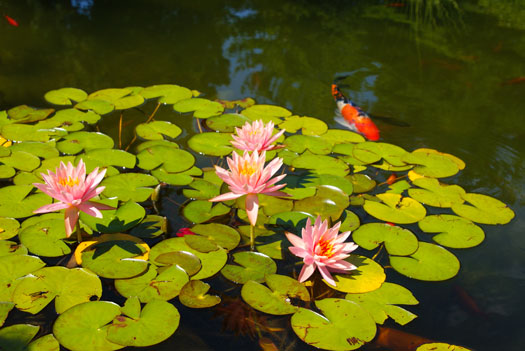- Your shopping cart is empty!
What to Put in a Pond Aside from Koi Fish

Aquarists who keep ponds in their properties are essentially recreating habitats that are smaller and more shallow than lakes. As such, many of the species that thrive in natural pond ecosystems could be introduced to koi ponds, but this will depend on the level of care and involvement fish keepers are willing to put into their aquatic habitats. Koi will do fine by themselves in a pond. However, habitats with a greater diversity of species are considered to be healthier and more efficient ecosystems. Look into shubunkins for a different type of fish, or maybe even paradise fish of hi-fin sharks. There are several types of aquatic life you can introduce to your pond for the purpose of making it a livelier place. The staff at aquatic Warehouse, a leading provider of koi pond supplies, has a few suggestions.
Pond Plankton
The links in the food chain of a koi pond start with bacteria, phytoplankton, and zooplankton before getting to plants, fish, and other creatures. With the exception of algae formation, you won’t become aware of plankton in your pond, but you’ll want to ensure it develops. A microbial loop needs to happen when you establish a pond and before adding koi. To make this happen, you’ll need to set up the aeration and filtration systems along with biological filter media. And don’t forget a surface skimmer! Water treatment kits for ponds often include bottled bacteria to kickstart the microbial loop, which tends to work out better when your backyard pond project starts in the spring.
Plants
A pond with a lot of aquatic plants will always be a happier and healthier pond. Seasoned koi keepers will tell you that starting out with plants is always better, particularly in sunny regions such as Arizona, California, and Florida. Floating plants aren’t only easy to take care of but will also keep harmful algae from growing in the pond. You simply cannot go wrong with water lotus, water hyacinths, and lilies. Furthermore, elodea and horsetail plant species will hold onto the substrate and provide nourishment for fish while oxygenating water through a biochemical process.
Japanese Trapdoor Snails
A backyard koi pond is an aquatic garden. For this reason, you should expect snails to naturally start migrating to your pond, whereupon they’ll become part of the food chain and consumed by koi, but they can also become a nuisance to your floating plants. Japanese trapdoor snails are the kind of snails you want in your pond because they’re avid algae eaters that don’t reproduce too much. As long as your koi are on a regular feeding schedule, they’ll only eat trapdoor snails occasionally.
Crayfish
Adding this curious species to your new pond after plants have taken hold is an excellent way to establish the habitat and advance the nitrogen cycle. These crustaceans are plentiful in the American South, and they’re more effective at controlling algae growth than snails. In fact, they’ll generally take care of everything the koi don’t consume, thus keeping the substrate clean. Make sure you have small piles of rocks at the bottom so the crayfish can burrow and hide.
To properly care for you pond and the creatures and plants that live in it, you’ll need to acquire all of the necessary supplies. From pond filters and pumps to nutritious koi food and lighting, Aquatic Warehouse has everything you need to keep the life in your pond healthy and happy. If you’d like to speak with one of our friendly and knowledgeable representatives, please give us a call today at 858-467-9297.
